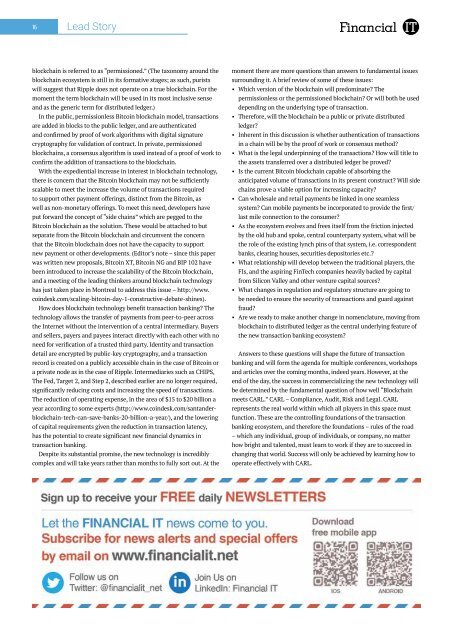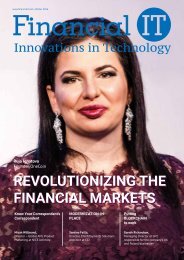Revolutionizing the Financial Markets
You also want an ePaper? Increase the reach of your titles
YUMPU automatically turns print PDFs into web optimized ePapers that Google loves.
16<br />
Lead Story<br />
blockchain is referred to as “permissioned.” (The taxonomy around <strong>the</strong><br />
blockchain ecosystem is still in its formative stages; as such, purists<br />
will suggest that Ripple does not operate on a true blockchain. For <strong>the</strong><br />
moment <strong>the</strong> term blockchain will be used in its most inclusive sense<br />
and as <strong>the</strong> generic term for distributed ledger.)<br />
In <strong>the</strong> public, permissionless Bitcoin blockchain model, transactions<br />
are added in blocks to <strong>the</strong> public ledger, and are au<strong>the</strong>nticated<br />
and confirmed by proof of work algorithms with digital signature<br />
cryptography for validation of contract. In private, permissioned<br />
blockchains, a consensus algorithm is used instead of a proof of work to<br />
confirm <strong>the</strong> addition of transactions to <strong>the</strong> blockchain.<br />
With <strong>the</strong> expediential increase in interest in blockchain technology,<br />
<strong>the</strong>re is concern that <strong>the</strong> Bitcoin blockchain may not be sufficiently<br />
scalable to meet <strong>the</strong> increase <strong>the</strong> volume of transactions required<br />
to support o<strong>the</strong>r payment offerings, distinct from <strong>the</strong> Bitcoin, as<br />
well as non-monetary offerings. To meet this need, developers have<br />
put forward <strong>the</strong> concept of “side chains” which are pegged to <strong>the</strong><br />
Bitcoin blockchain as <strong>the</strong> solution. These would be attached to but<br />
separate from <strong>the</strong> Bitcoin blockchain and circumvent <strong>the</strong> concern<br />
that <strong>the</strong> Bitcoin blockchain does not have <strong>the</strong> capacity to support<br />
new payment or o<strong>the</strong>r developments. (Editor’s note – since this paper<br />
was written new proposals, Bitcoin XT, Bitcoin NG and BIP 102 have<br />
been introduced to increase <strong>the</strong> scalability of <strong>the</strong> Bitcoin blockchain,<br />
and a meeting of <strong>the</strong> leading thinkers around blockchain technology<br />
has just taken place in Montreal to address this issue – http://www.<br />
coindesk.com/scaling-bitcoin-day-1-constructive-debate-shines).<br />
How does blockchain technology benefit transaction banking? The<br />
technology allows <strong>the</strong> transfer of payments from peer-to-peer across<br />
<strong>the</strong> Internet without <strong>the</strong> intervention of a central intermediary. Buyers<br />
and sellers, payers and payees interact directly with each o<strong>the</strong>r with no<br />
need for verification of a trusted third party. Identity and transaction<br />
detail are encrypted by public-key cryptography, and a transaction<br />
record is created on a publicly accessible chain in <strong>the</strong> case of Bitcoin or<br />
a private node as in <strong>the</strong> case of Ripple. Intermediaries such as CHIPS,<br />
The Fed, Target 2, and Step 2, described earlier are no longer required,<br />
significantly reducing costs and increasing <strong>the</strong> speed of transactions.<br />
The reduction of operating expense, in <strong>the</strong> area of $15 to $20 billion a<br />
year according to some experts (http://www.coindesk.com/santanderblockchain-tech-can-save-banks-20-billion-a-year/),<br />
and <strong>the</strong> lowering<br />
of capital requirements given <strong>the</strong> reduction in transaction latency,<br />
has <strong>the</strong> potential to create significant new financial dynamics in<br />
transaction banking.<br />
Despite its substantial promise, <strong>the</strong> new technology is incredibly<br />
complex and will take years ra<strong>the</strong>r than months to fully sort out. At <strong>the</strong><br />
moment <strong>the</strong>re are more questions than answers to fundamental issues<br />
surrounding it. A brief review of some of <strong>the</strong>se issues:<br />
• Which version of <strong>the</strong> blockchain will predominate? The<br />
permissionless or <strong>the</strong> permissioned blockchain? Or will both be used<br />
depending on <strong>the</strong> underlying type of transaction.<br />
• Therefore, will <strong>the</strong> blockchain be a public or private distributed<br />
ledger?<br />
• Inherent in this discussion is whe<strong>the</strong>r au<strong>the</strong>ntication of transactions<br />
in a chain will be by <strong>the</strong> proof of work or consensus method?<br />
• What is <strong>the</strong> legal underpinning of <strong>the</strong> transactions? How will title to<br />
<strong>the</strong> assets transferred over a distributed ledger be proved?<br />
• Is <strong>the</strong> current Bitcoin blockchain capable of absorbing <strong>the</strong><br />
anticipated volume of transactions in its present construct? Will side<br />
chains prove a viable option for increasing capacity?<br />
• Can wholesale and retail payments be linked in one seamless<br />
system? Can mobile payments be incorporated to provide <strong>the</strong> first/<br />
last mile connection to <strong>the</strong> consumer?<br />
• As <strong>the</strong> ecosystem evolves and frees itself from <strong>the</strong> friction injected<br />
by <strong>the</strong> old hub and spoke, central counterparty system, what will be<br />
<strong>the</strong> role of <strong>the</strong> existing lynch pins of that system, i.e. correspondent<br />
banks, clearing houses, securities depositories etc.?<br />
• What relationship will develop between <strong>the</strong> traditional players, <strong>the</strong><br />
FIs, and <strong>the</strong> aspiring FinTech companies heavily backed by capital<br />
from Silicon Valley and o<strong>the</strong>r venture capital sources?<br />
• What changes in regulation and regulatory structure are going to<br />
be needed to ensure <strong>the</strong> security of transactions and guard against<br />
fraud?<br />
• Are we ready to make ano<strong>the</strong>r change in nomenclature, moving from<br />
blockchain to distributed ledger as <strong>the</strong> central underlying feature of<br />
<strong>the</strong> new transaction banking ecosystem?<br />
Answers to <strong>the</strong>se questions will shape <strong>the</strong> future of transaction<br />
banking and will form <strong>the</strong> agenda for multiple conferences, workshops<br />
and articles over <strong>the</strong> coming months, indeed years. However, at <strong>the</strong><br />
end of <strong>the</strong> day, <strong>the</strong> success in commercializing <strong>the</strong> new technology will<br />
be determined by <strong>the</strong> fundamental question of how well “Blockchain<br />
meets CARL.” CARL – Compliance, Audit, Risk and Legal. CARL<br />
represents <strong>the</strong> real world within which all players in this space must<br />
function. These are <strong>the</strong> controlling foundations of <strong>the</strong> transaction<br />
banking ecosystem, and <strong>the</strong>refore <strong>the</strong> foundations – rules of <strong>the</strong> road<br />
– which any individual, group of individuals, or company, no matter<br />
how bright and talented, must learn to work if <strong>the</strong>y are to succeed in<br />
changing that world. Success will only be achieved by learning how to<br />
operate effectively with CARL.







